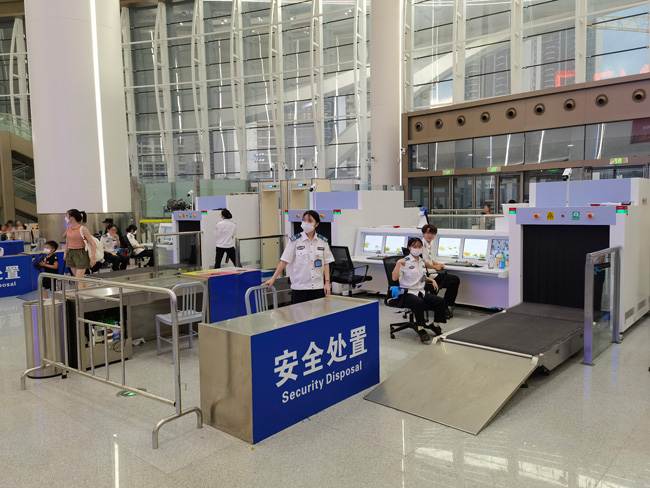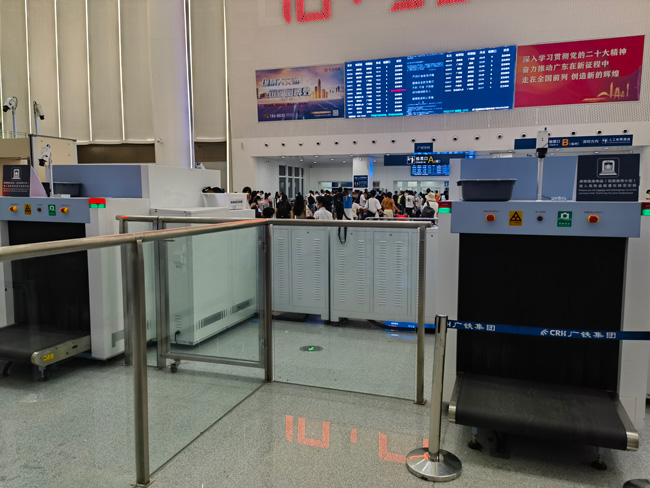In recent years, China has made significant strides in bolstering security measures across its vast transportation network. One crucial aspect of this effort is the installation of securityXray baggage scanners at train stations throughout the country. These state-of-the-art scanning systems have become instrumental in safeguarding passengers, detecting potential threats, and streamlining the security screening process. .
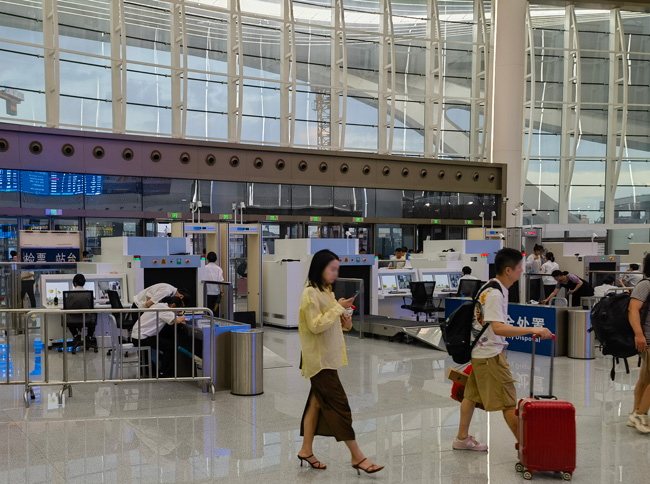
1. The Imperative of Enhanced Security:
With the increasing global security challenges and the need to protect citizens and infrastructure, China recognized the necessity of elevating security measures within its transportation hubs. Train stations, being major transit points accommodating millions of passengers each day, were a natural focus for security enhancement. Security baggage scanners were chosen due to their ability to swiftly and accurately screen luggage for prohibited items and potential threats.
The
railway transportation system occupies an important position in China,
undertaking a large number of passenger and freight tasks. With the rapid
development of the railway network, railway safety issues have become
increasingly prominent. China's railway security inspection has gradually
changed from traditional manual security inspection to modern and intelligent
security inspection mode.
2. Timeline of Implementation:
Since
the 90s of the 20th century, China's railway authorities have begun to try to
introduce security inspection equipment, such as walk through metal detection doors, baggage X-ray security inspection machines, etc. In the early 2000s,
China's railway authorities strengthened safety management and carried out
comprehensive safety upgrades to stations. In the 2010s, with the advancement
of science and technology, China's railway security inspection began to use
high-tech means such as face recognition and biometric recognition. In
addition, it also uses big data, cloud computing and other technical means to
realize real-time monitoring and rapid processing of security inspection
information.
Over the years, the initiative rapidly expanded to cover all major stations, regional hubs, and key transportation nodes, forming an interconnected web of security checkpoints. The goal was to establish a seamless and standardized security system to ensure passenger safety and maintain efficient operations.
At
present, the methods and methods adopted by China's railway security inspection
include the following aspects:
2.1. Manual check: Passengers are required to present a valid ID when entering the
station, and the staff will verify their identity and check the ticket. In
addition, staff conduct routine baggage checks to ensure that passengers do not
bring prohibited items on board.
2.2. Security checking equipment: The station is equipped with metal detection
doors, baggage scanner X-ray security scanner machines and other equipment to conduct
security checks on passengers and luggage. These devices can detect metal
objects, liquids and other contraband items carried, effectively reducing
safety hazards.
2.3. Face recognition and biometric recognition: Through the camera installed at the
station, the face recognition of incoming passengers is carried out and
compared with the ID card information to ensure the authenticity of passenger
information. At the same time, biometric technology, such as fingerprint
recognition, iris recognition, etc., is used to further strengthen security
precautions.
2.4. Big data and cloud computing: use big data technology to monitor security check
information in real time and provide early warning of suspected abnormal
behavior. Through cloud computing technology, the security check information of
each station is summarized and analyzed, and the decision support is provided
for the railway safety management department.
2.5. Safety training and emergency drills: Regularly conduct safety training for
railway staff to improve their ability to respond to emergencies. At the same
time, emergency drills are regularly organized to simulate the handling process
of various safety accidents and improve emergency response capabilities.
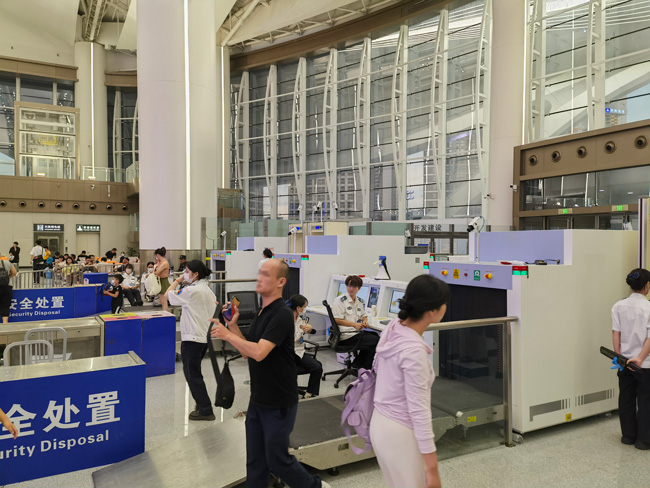
3. How X-ray Baggage Scanners Work:
X-ray baggage scanners employ cutting edge technology to provide detailed images of luggage contents. Passengers place their bags on the conveyor belt, and the scanner generates a high-resolution Xray image of the baggage contents. The image is then analyzed by trained security personnel who can quickly identify any potential threats or prohibited items. The scanners are nonintrusive, ensuring passenger privacy while maintaining a high level of security.
4. Benefits of X-ray Baggage Scanners:
a. Enhanced Threat Detection: baggage inspection x-ray
machine can identify wide range of potential threats, including weapons, explosives, and contraband items. This proactive approach strengthens overall security and deters potential perpetrators.
b. Streamlined Screening Process: With security x-ray screening system, security checks become more efficient, reducing wait times and ensuring smooth passenger flow through train stations.
c. Passenger Confidence: The presence of advanced security measures, such as Xray baggage scanners, instills confidence in travelers, contributing to a positive and secure passenger experience.
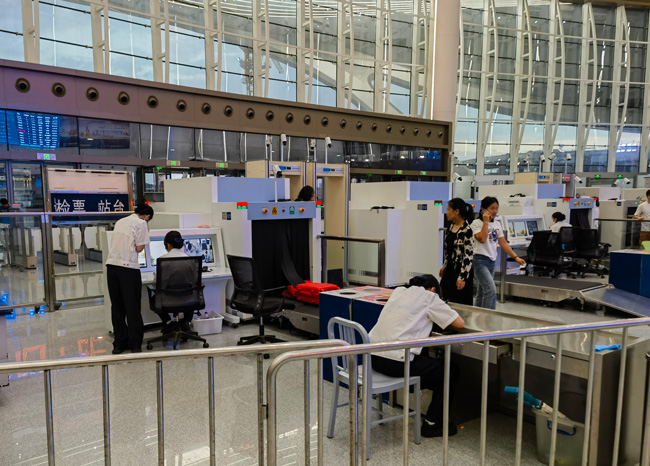
5. Continuous Advancements in X-ray Technology:
To
stay ahead of evolving threats, China’s train stations continually update the
baggage scanners with the latest advancements in imaging technology. These
upgrades ensure that the scanners remain effective in detecting new and
emerging threats while maintaining passenger convenience.
6. Collaboration with Security Experts:
China’s
railway authorities collaborate closely with security experts and technology
providers to optimize the deployment and functionality of security X-ray
airport scanners. Expert insights and ongoing feedback enable continuous
improvements in the effectiveness of security measures.
7. Public Awareness and Education:
The
implementation of X-ray baggage scanners also includes public awareness
campaigns to inform passengers about the importance of security measures and
the proper procedures for using the scanners. Educating the public fosters a
culture of cooperation and compliance, further enhancing security efforts.
8. Global Best Practices:
China's approach to implementing Xray baggage scanners draws on global best practices in transportation security. By studying and incorporating successful strategies from around the world, China ensures its security measures align with international standards.
In
conclusion, the installation of X-ray baggage scanners at train stations in
China marks a significant step forward in enhancing security across the
national railway network. Through the deployment of advanced technology,
continuous upgrades, collaboration with security experts, and public awareness
initiatives, China’s train stations have created a secure and efficient travel
environment for millions of passengers. The widespread adoption of X-ray
baggage scanners serves as a testament to China’s commitment to passenger
safety and underscores the country’s position as a global leader in
transportation security.
